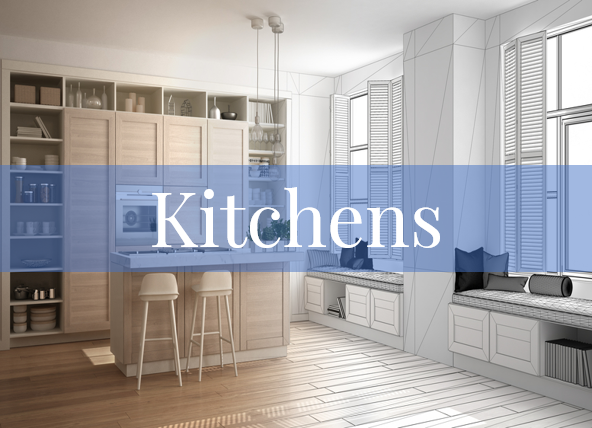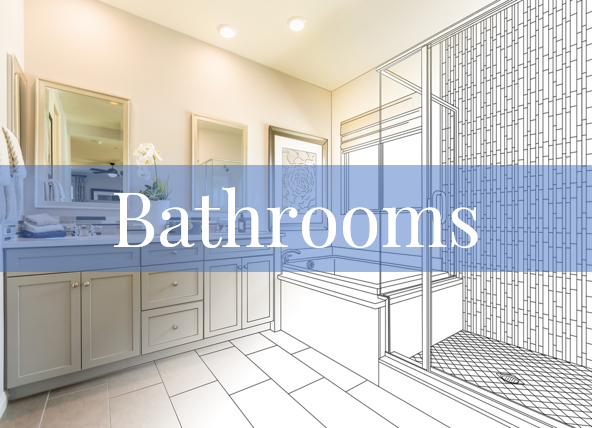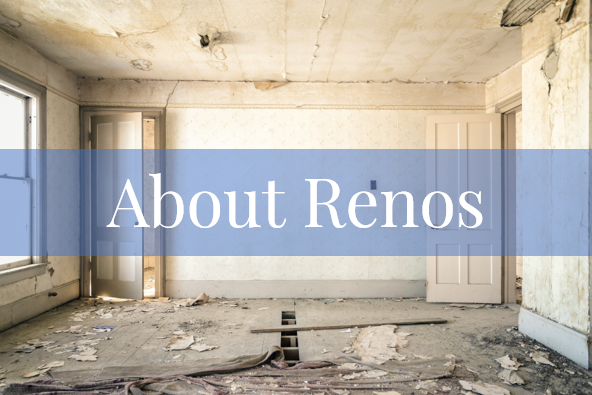European Laundry: Is It the Right Choice for Your Laundry Room?
/This laundry closet was created as part of a kitchen renovation we did for our clients in Oshawa. The client purchased her appliances in advance so we could build the “closet” to suit.
We spend a lot of time doing laundry—probably more than most of us would like! I’m always looking for ways to make it more efficient and functional, as well as a more pleasant place to do a rather unpleasant task.
I’m not getting any younger! A friend of mine (who happens to be older than me) once told me that everything starts to fall apart when you hit 50 and you feel every ache and pain. She was right! My laundry room is in my basement, which means trudging up and down two flights of stairs every time I want to do laundry. With a torn meniscus in one knee and arthritis in both, there are many weeks when I keep putting off doing the laundry, which only makes it worse because then I end up with 4 loads to do!
Working for a renovation company, I knew there were several options for what I could do to move the laundry facilities to a more functional space. For my needs, I decided a European laundry fit the bill.
Prefer to listen?
So what exactly is a European laundry?
European laundry with stacked washer and dryer inside of a large ensuite bathroom
By definition, a European laundry is a laundry "room" that’s tucked away inside a cupboard or closet, usually hidden behind bifold or pocket doors. A European laundry can be out in the open, but instead of being in its own room, it’s in the powder room, washroom, or kitchen. We most commonly find European laundries in kitchens in Britain. You can also see it in a multi-purpose room, such as a mud room.
For me, I plan on putting a stacked washer and dryer in my main floor powder room. When I bought the house I’m currently in, there was a bidet in the powder room. Now I’m never going to use that, except maybe as a cool drinking fountain for the cats! So one of the first things I did was remove it and sell it! That left an open space there that I’ve never used for anything other than storage. It’s now going to become my European laundry.
What are the advantages of a European laundry?
Washer and dryer become part of the kitchen design in this open concept layout. This creates a lot of added convenience allowing the homeowner to do laundry and cook dinner at the same time.
It takes up less space than having an entire room dedicated to laundry. This frees up your old laundry room for another purpose.
You can tuck your washer and dryer into a very small space that might not otherwise have a use.
We often see European laundries next to or in a kitchen, so this adds convenience. We spend a lot of time on the main floor, and in particular, in the kitchen, so having the laundry close by allows you to get laundry done while making dinner.
If you install the European laundry near or in the kitchen, powder room, or washroom, the plumbing costs will be lower as you are close to the water supply and drainage lines.
You can close the doors, and it will hide your laundry. It will typically look like a closet, and your guests will be none the wiser.
What’s Needed to Create a European Laundry?
Stacking the washer and dryer allows you to squeeze the laundry facilities into a small space, particularly in a bathroom.
Before you decide that this is the right option for you, you will need to ensure you have a few things in place first.
Ensure you have enough ventilation in the area where you are planning on putting the laundry. As both the washer and dryer create heat and some humidity, you will need to ensure you have space around the machines to disperse it.
Make sure you buy your appliances, or at the very least make sure you know which appliances you will be buying, that they are in stock, and what the specs or dimensions are. You will need this information in order to determine if the machines will fit in the space you plan on using as the European laundry.
We had an issue with one European laundry we were creating for our client. She had ordered her washer and dryer and provided us with the measurements of the units. The appliances hadn’t arrived yet, but we agreed to start construction as they were expected soon. We built the laundry closet according to the measurements she gave us. We already had it completed, but the appliances still hadn’t arrived. When she called the store she purchased them from, she found out they were indefinitely backordered. She was able to order a different washer and dryer, but they were a different size! This meant having to strip off drywall and rework the size of the closet to suit. This was a lot of wasted time and money! Lesson learned! Don’t start construction on your laundry closet until the appliances are on site!
You will also want to make sure you plan to level your appliances to decrease the amount of vibration they create. Usually the appliances have feet that allow you to level the machine. However, some of our clients have opted to have their appliances raised up on a slight subfloor, thereby minimizing the vibration even more with the addition of vibration pads.
Consider whether you truly need a laundry tub at the European laundry. The whole idea of a European laundry is that it doesn’t take up much room and can be squeezed into a small, otherwise unused space. Do you really need a laundry tub in that space? If you use a laundry tub for doing your laundry, then your answer is yes! Make sure you consider this when planning the amount of space you will need. However, if you don’t use it much or mainly for rinsing out paint brushes, then locate it in the basement and keep your laundry closet just for the appliances.
Do you want a broom closet, ironing board, or linen cupboard as part of your laundry area? If so, you will need to plan for this as well. There are ways to still have a compact European laundry and incorporate some of this into the space. For example, you could use a 10" deep by 12" wide utility closet as your broom closet. This takes up very little space but still provides the necessary storage. Your ironing board can be stored "inside" a wall and just be tipped down when needed, only to be tucked back up again (like a Murphy bed) when not in use. Laundry cabinets or a linen tower are a little tougher. You will need to make sure you allow the necessary space for these items if they are a necessity in your laundry space.
Additional Features to Consider for a Laundry Closet
When the closet door is closed, you would never know there was a washer and dryer within this bathroom.
Because a European laundry is usually on the main or second floor of your home, you will want to have solid or sound-proofed doors on it. This will allow you to run the washer or dryer and not be disturbed by the noise.
Consider insulating the walls around the appliances. This will go a long way toward reducing the noise from them as well. You will want to decide on this before the drywall goes up. We recommend Roxul Safe ‘n Sound Insulation. It is a stone wool insulation that is not only non-combustible but has excellent acoustical dampening properties as well.
Consider where the best location is for your laundry closet. A client of ours wanted to put the laundry in the front hall closet since that closet was never used and it was the right size for her appliances, so no construction was needed to build a closet. However, the money she would have saved on carpentry was wiped out and then some because that closet was nowhere near any plumbing lines. She would have spent far more money running the plumbing pipes to that location than she ended up spending on the location we used for the laundry closet, which was next to the powder room. Consider locating the European laundry close to or even inside a powder room, bathroom, or kitchen.
Consider stacking your washer and dryer to save space. You’ll be surprised at how little room you need for a laundry closet when you stack your washer and dryer. Many of our clients have been able to locate the European laundry within a powder room or bathroom by stacking the machines.
If you are positioning the appliances side by side, consider elevating them on a pedestal. This will make the laundry task much easier on your back and, overall, a lot more pleasant. You can often order matching pedestals from the manufacturer or store where you bought the appliances, or you can have one custom made out of wood.
Ensure your dryer gets vented to the exterior. This may mean venting through the roof if on the 2nd floor or through the side of your house. It’s usually a 4" duct, so make sure you have the space for the ductwork.
Make sure you keep the area well lit. Especially if you’re creating the European laundry in a closet, make sure you have lighting either within the closet or just outside of it. Use task lighting, such as a recessed LED pot light, for the best results.
Make sure you install an exhaust fan in the space. This is not only a Building Code requirement but it will go a long way to getting rid of the excess heat and humidity that your appliances will create. We recommend a minimum 80 CFM exhaust fan. Look for one that’s 1.2 sones or lower to ensure it’s not too loud.
If you have a closet as opposed to the appliances being out in the open within your space, consider installing an auto on/off switch for the light fixture. This will have the light automatically turn on when you open the door to the closet and then turn off when the door is closed. It’s a neat feature at minimal cost.
Over our lifetime, we spend 384 days doing laundry. That’s a lot of laundry and a lot of time spent doing a task that most of us don’t care for very much. In order to make it less of a chore, we need to make the space functional, efficient, and pleasant. Consider creating a European laundry in your home to serve that purpose.
To learn more about laundry room renovations, check out my blog, “Is It Time to Renovate Your Laundry Room?”
Need some help selecting just the right contractor to create your new laundry facility? Make sure you read How to Choose a Reputable Contractor.


























